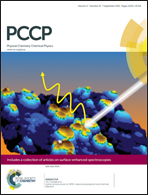Density functional theory calculations of the hydrazine decomposition mechanism on the planar and stepped Cu(111) surfaces
Abstract
We have investigated the adsorption of hydrazine (N2H4) and its reactivity on terraces and steps of Cu(111) surfaces by first-principles calculations in order to gain insight into the hydrazine decomposition mechanism. We have investigated different possibilities for the N–N and N–H bond cleavage for any intermediate states by analysing the reaction and barrier energies of each elementary step. We have found that hydrazine dehydrogenation via N–H bond scission is neither energetically nor kinetically favourable on the flat and stepped surfaces, but hydrazine prefers to form NH2via N–N bond decoupling on the Cu(111) with an activation energy below 1 eV. The NH2 molecule reacts fairly easily with co-adsorbed NH2 to form NH3 as well as with N2Hx (x = 1–4) by abstracting hydrogen to produce NH3 and N2 molecules on both the flat and stepped surfaces. We also found that all intermediates except NNH prefer N–N bond breaking as the most likely dissociation pathway, where the amide and imide intermediates produced can be hydrogenated to form NH3 in the presence of hydrogen. NNH is the only intermediate, which prefers to dissociate via a highly exothermic N–H bond breaking process to produce an N2 molecule after overcoming a small barrier energy. We also studied the production of H2 by recombination of hydrogen ad-atoms which, considering the activation energies, is particularly favoured under conditions of moderate temperatures. Our results agree well with experiments suggesting that N2H4 adsorbs dissociatively on copper above ∼300 K leading to N2, NH3 and H2. In general, the lower coordination of the steps is found to lead to higher reactivity than on the flat Cu(111) surface. Furthermore, the calculations show that the influence of step edge atoms is very different for the intra- and intermolecular dehydrogenation mechanisms. They also increase the barrier of N–N decoupling of all the existing species in the reaction.


 Please wait while we load your content...
Please wait while we load your content...